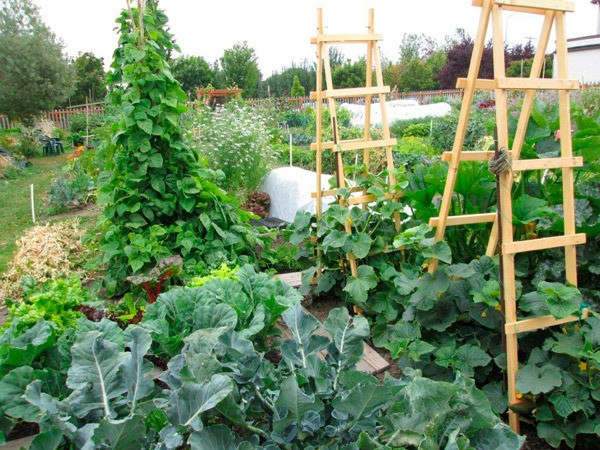Basic rules for building trellises
When building a trellis, let your imagination run wild, but always follow these basic rules.
1. Use sturdy materials that can handle the weight of the plant as it grows. Anchor your trellis by sinking support posts deep into the ground.
2. Match the support to the plant. Knowing the plant’s growing tendencies can help you choose the right support structure.
3. Install the supports when you plant. You can damage roots by sticking supports into the ground after planting or break vines trying to lift them off the ground.
4. Situate trellises along the north side of your garden so trellised plants do not cast a shadow over nearby plants, inhibiting their growth. Or if needed, a trellis can be positioned to create a shadier area to protect sun-sensitive crops.
Trellising plants in the vegetable garden is an art, a science and a lesson in practicality, all in one!
Although it is unknown when and where the trellis was invented, such structures have been mentioned in literature and botanical writings throughout history. Trellises continue to be used in vegetable gardens (and berry patches) today for many good reasons.
Trellising capitalizes on vertical space and frees up precious real estate for other crops. As a result, you can grow more fruits and vegetables in the same space and increase your yield per square foot of garden.
Trellises minimize disease and pest damage on fruits and vegetables. They improve air circulation around plants and maximize exposure to sunlight, helping to prevent the buildup of moisture on leaves.
This in turn discourages fungal and other diseases. Getting the plants off the ground also decreases damage by snails, mice and other ground pests.
Growing your vegetable plants on trellises makes tending your garden and finding (and picking) produce easier. This feature is particularly desirable for gardeners with physical challenges because they often can tend the garden and harvest from a standing position or a garden seat.
Trellised plants create a shady area for plants growing beneath the canopy. If you take advantage of this cooler zone, you can grow cool-weather crops, such as spinach and brassicas, well into the heat of summer.
Trellises also add character to your garden; they can be used to display the ornamental aspect of a plant, decorate an otherwise barren wall and hide less attractive spots in your garden.
Trellises come in a wide variety of shapes, styles and materials. Supports can be made out of fencing, wood, PVC or metal pipes, other plants such as sunflowers and sweet corn, just about anything! Common shapes include teepees, A-frames, vertical fencing, cages and ladders.
Be creative, but always follow a few basic rules to make sure your trellis is able to do the job for which it was built. (See sidebar.)
Which vegetables benefit from trellises and supports? Climbing and vining crops such as pole and runner beans, peas, small-fruited squash and cucumbers do well when supported by a trellis. Tomatoes are more productive and produce earlier when trellised or supported by a tomato cage.
If you choose to trellis vegetables with larger fruits (larger squash or melons), you likely will need to provide additional support (such as individual hammocks) to prevent the fruit from separating from the vine prematurely.
Why not lure your vegetable crops toward the sky this year? Trellising is a great way to increase your harvest, improve its quality and make gardening easier for you. Give it a try.
Pearl of Wisdom
When using trellises, check your plants frequently and guide their growth so that they get the most support. If you need to tie plant branches to the trellis, use soft materials (such as fabric strips or old pantyhose) and loop the tie around the support, cross the two ends
and loop them around the plant stem (forming a figure eight) before tying to prevent damage to the stem as it moves with wind, rain and its own weight.
Judy English and Jeanette Stehr-Green are WSU-certified Clallam County Master Gardeners.
Note: For more gardening information, attend a Saturday in the Garden presentation at the Master Gardener Demonstration Garden at 2711 Woodcock Road in Sequim. These free educational events are held on selected Saturdays.
On June 4, Clallam County Master Gardener Jeanette Stehr-Green and food preservationist Betsy Wharton will talk about “Growing and Preserving Berries.”
Call Lorrie at 565-2679 for more details and to register for this workshop.



